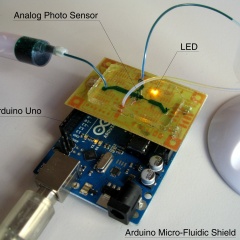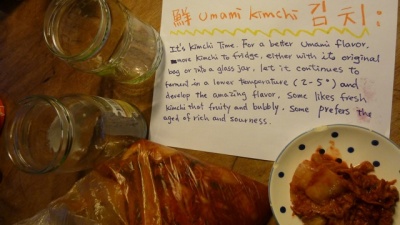KopenLab
Hackteria @ The Kopenlab Festival 21 - 26 June, 2014
Hackteria @ KopenLab Festival 2014
At the the early developing stage of HLab14, the co-organiser of KopenLab Martin Malthe Borch joined several skype meetings and eventually came to Yogyakarta to partake HackteriaLab 2014 between 13 - 28 April. The exchange amongst artistic context and citizen science lead to several spontaneous workshops and continuous researches which now we bring few of them to KopenLab dated 21 - 26 June. More details about the background of KopenLab & ESOF – Euroscience Open Forum see http://kopenlab.dk
Workshop : Shake It Baby
by Urs, Kiilo
21 June 12h - 16h
Oneliner: "Shake it Baby" workshop where we make all kind of liquid shakers like:
- Horizontal Tube Rotator - Gjino Style, link?
etc. (anyone?)
Description:shaker contoller with timer and all, when we finish the shaker we can mix some drinks and "shake it baby".
Need on site:We plan to develop a special microcontoller shaker driver electronic that would cost around 20 euro. Then we need tubes, petridish, spare stepper motors, gear motors, CD/DVD drives, foam board and hot glue, soldering iron and wire for the workshop. When all participant finished their shaker we can mix some drinks and "shake it baby". (material kit for sale to participant around 20 EURO)"cutters, magnets for magnetic shaker and rubber...
Mentor:
- Dipl. Ing. Urs Gaudenz, Switzerland – 1971. Urs Gaudenz is microengineer and founder of GaudiLabs. He worked for Swiss high tech companies in the field of micro sensor technology (sensirion.com) and brushless motor control. With his solid background in electronics, mechanics and software he is working in a concurrent style between the disciplines. After several years of experience as a consultant in innovation management he is now engaged as lecturer for product innovation at the Lucerne University of Applied Science and Arts. His aim is to evolve towards more balanced collaborative entities in social action, business and technology.
- Kiilo, new media artist, a Neo-Dadaist and software programmer who likes to bridge object and code. Kiilo's interdisciplinary and improvisational approaches are influenced by his background of physics, special education and new media art. His current researches include the development of The Turtle project, it is an educational module for teaching young and older children about the basic concepts of coding and physical computing and to combine with his interests in cybernetic art and internet of thing (IoT).
Links:http://hackteria.org/wiki/KopenLab | http://www.gaudi.ch | http://kiilo.org
A protocol or manual: that descripes what to do, that can be shared at, and after the festival to give the workshop some afterlife and underline the sharing and collaboration part.
Workshop: HomeMade Kimchi - Asian sourkraut
by Pei
21, 22, 23 June, 13h - 15h
Oneliner:Hands on to the interplay of time and temperture, prepare the ground for some bacteria to do the work, we make Kimchi.
Description: Kimchi is a very popular fermented pickle in Asian societies nowadays. In the western world, Kimchi is commonly refers to "baechu kimchi - napa cabbage pickle" known in Korea. The intricacy of flavour of Kimchi is done by the act of good bateria (meaning that we human like it). Fermented foods are the everyday diy bio art which have been practicing in many different societies in the world. The rather modern red form of Korean Kimchi processed with chilli flake was only came about some 500 yrs ago when chilli first traded to Korea.
In this open workshop, anyone, the participants are invited to join one or all of three blocks of Kimchi making in different stages, getting to know and/or experiment various of available vegetable (to replace Chinese Cabbage), fruit (to replace apple & pear), herbs (to replace ginger). But yes, Chinese Cabbage is the basic to start with ~
Kimchi usually contain fish sauce, a vegetarians form is in developing ~ more soon. Question, comment feel free to drop line to pei / vul3jp6p at gmail doc com
Note: Every child under the age of 8 must accompanied by an adult.
'
Mentor:Pei is an artist blending the artefacts of nature and culture, with a particular interest in soundscape and the making of it. She has been part of Hackteria network, coordinating art | tech | sci workshop and festival. Since 2012, She began to experiment the making of HomeMade Kimchi and not without failures and explosions.
Links:http://www.little-object.com / http://hackteria.org/wiki/KopenLab
A protocol or manual: >>> step-by-step introduction (aka protocol) if you like to do it at home ;')
I/III The Basic & The Ingredients, 21 June, 13h - 15h
- Intro to Asian Daily Cuisine involved fermentation, pickle (KIMCHI), tofu, tempe, nato, etc
- Getting to know the Basic & The Ingredients of DIY Kimchi
- Cut & Dehydrate the cabbage/other vegi experiments (Top secrete : the percentage of the salt !!)
IMPORTANT!:participant is recommended to bring your own Chinese Cabbage (500 grams or more) & a deep tray, which is deep enough for the amount of vegetable (cutted cabbages) to dehydrate by salt. / Other vegi experiment is encouraged when choosing the vegi which contained hight amount of water (nothing is guarantee).
II/III The Paste & The 1st fermentation, 22 June, 13h - 15h
- The paste - peel, chop, blend & cook (onion, garlic, ginger, apple, pear, carrot, spiring onion)~
- The food for Bacteria – cook the glutinous rice powder
- The mix and the fine tuning of the taste (lots of chilli flake, with or without fish sauce)
- Its all about the interplay of time and temperature
- Preparation for the 1st fermentation, stable temperature between 22 – 24 degrees
III/III The Taste & the 2nd fermentation, 23 June, 13h - 15h
- Tasting the first fermentation
- What is Lactobacillus acidophilus? Why is my Kimchi bubblies?
- Preparation for the 2nd fermentation
- Blender, cooker, mixing container, storing container, sticker to label, marker's pen, thermometer, temperature controlled container, gloves... (tbc)
- Fresh Ingredients - carrot, spring onion, apple, pear, giner, garlic, onion, sea salt~
- Paste Ingredients - Glutinous rice powder, dry chilli flake, fish sauce ~
Workshop: YOU, in the center of the world~ "sourrounded by machines of loving grace"
Oneliner:In this workshop you will get a peek into the core idea of machine computing, and how does this idea shapes the rise of social media.
Description:Following a short (20min) presentation this workshop gives you hands on experience on realtime tracking of social media. Participants are asked to bring their own laptop with Proccessing, Arduino and PD installed, and some daily household electric devices or electronic toys which reflect to the theme "smart cities", to represent and/or create a big collective machinery connected to social networks. Using social media gateways, a bi-direcitonal communcaiton can be established to control physical objects.
Related fields of practice: Physical Computing, Internet of Thing, Social Media, Humanity & Media Art.
Mentor:Tobias Hoffmann aka Kiilo. New Media Artist, a Neo-Dadaist and software programmer who likes to bridge object and code. Kiilo's interdisciplinary and improvisational approaches are influenced by his background of physics, special education and new media art. His current researches include the development of a Turtle project, it is an educational module for teaching young and older children about the basic concepts of coding and physical computing and to combine with his interests in cybernetic art and internet of thing (IoT).
Links:http://playaround.cc | http://kiilo.kiilo.org
Exhibition: Please Try This at Home
// part of HLab14 - Yogyakarta will be shown as case study
- Wild Open PCR (confirmed)
- workshopologie, instruction on t-shirt (not yet confirmed)
The exhibition “Please Try This at Home” is an open invitation to explore the interdisciplinary universe where art, science and technology cross-fertilize and form a creative environment for development of new ideas, experiments and inventions.
We believe knowledge should be accessible to everyone and therefore the focus is on hacks, artworks, and artifacts that are all open for the audience to re-enact, copy and develop further - the audience are not consumers, but active contributors and co-creators in the development of new citizen science.
The exhibition shows works from around the world and from various communities, artists, researchers etc. For instance you can experience how open hardware such as the prototyping platform Arduino or the 3D printer RepRap has affected our creative processes and the way we invent, produce and design new objects. And you can experience international artists working with new biological signals, biomechanics, drones, 3D printing, robots and more.
Understanding human/machine interaction in the digital age is of critical importance therefore we are aiming to create a new setting for knowledge sharing, dialogue and development within the public sphere. We hope that you will investigate the things exhibited - and please participate and continue the experiments at home!
KopenLab Location
Address. Map.
KopenLab Team
- KopenLab Co-organiser - Emil L Polny: emilpolny at gmail doc com
- KopenLab Co-organiser - Martin M Borch: mmborch at gmail doc com
- Exhibition Curator - Majken Overgaard: majkenovergaard at gmail doc com
Hackteria Team
- Urs Gaudenz (CH) http://gaudi.ch
- Tobias Hoffmann aka Kiilo (DE/CH) http://kiilo.org
- Pei (TW/CH) http://playaround.cc
- Marc Dusseiller (CH) http://www.dusseiller.ch
- Bengt Sjölén (SE) - semi confirmed, http://automata.se
- Brian Degger (uk) - if you want me ;)














